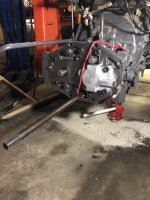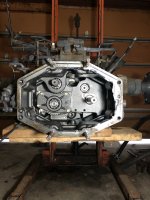Great pictures & story. I don't know anything about HST and swashplate wear, so please bear with my questions.....this is all new to me. Is it common for the wear on the cradle bearings to be so off-center? I'm assuming that the screw is in the center.... but looking at those shell bearings, they look to me to be much more worn on one end than the other. Is that common?
s
That off-center wear makes me thnk that the swash plate had/has a different radius - slightly smaller - than the radius of the shell bearing or cradle, and also that the entire cradle bearing plate was mouned slightly off-center to the swash plate.
If either or both of those were true, then there would be a lot of bearing wear happening until enough bearing surface was in contact with the swash plate to support the load. That could explain the large amount of wear with relatively low hours. In fact, if slightly different radius & off-center then all that wear could happen very quickly.
Why else would it wear more on one end than the other? Or am I missing something here?
As for the loctite, there's no downside to using it here. There are specialized loctite compounds for every type of application imaginable. If I was going to use that screw, I'd use Loctite as well as expose the threads on the opposite end enough to peen or somehow lock the screw mechanicially. But why have the screw in the first place? I'm kind of surprised that the screw is there at all. I'd expect that the bearing shell would be trapped in place when the cradle is bolted up & that would be my design preference.
rScotty
I don't really know anything about HST either so please bear with me too.
Regarding possible radius difference I don't believe there is much of one, if any. I tried feeler gauges at the ends of the new bearings and didn't find gaps with the swash plate. With a film of oil it moves in the new cradle smoothly with no detectable radial or side clearance.
The swash plate doesn't have fixed axes - it floats however the cradle dictates and is only restrained by the bearings. The other side has a near-mirror finish for the pump slippers.
I believe uneven wear can result from how a machine is operated.
For loader work, its common to either fill or empty the bucket while moving forward slowly or even stopped. Then it is shifted into reverse to move away. However shifts from reverse to forward often take place while the machine is still rolling backward. I think too much of that can eventually produce uneven cradle bearing wear.
Moving the HST pedal to a desired position establishes a regulator set point that puts hydraulic pressure on the servo piston, moving the swash plate accordingly. Once the set point is reached the swash plate stays still until the pedal is moved somewhere else.
In Kubota HSTs with side-by-side pump and motor, the top of the swash plate leans away from the engine in reverse, and leans toward the engine in forward. It's vertical in neutral.
Shifting to forward causes the servo piston to move the swash plate down, rubbing against the lower area of the cradle, and tilting the top of the swash plate toward the engine. The piston load persists until the machine is moving forward at the desired speed. If an operator doing loader work tends to move the machine quickly and/or shift to forward while moving backward, the lower part of the swash plate and cradle is loaded more of the time than the upper part. Its the lower part of our cradle that's worn more.
Another detail that affects swash plate loading is the external damper on the pedal linkage. It's there to prevent spiking hydraulic pressure due to abrupt shifting (stomping the pedal). Its a 2-way gas shock - they wear out - and if not functioning the system is more exposed to high momentary loads - and cradle wear.
Regarding retaining the bearings, without the screw nothing prevents them sliding out of position. Dave's bearings in his Bondioli Pavesi cover more of the circle and have a pin too. I like your idea of a containing pocket - there's plenty of room in there to improve it but modifying an existing one is not practical. The basic problem is the present bearing material isn't tough enough for the application. Dick B.


